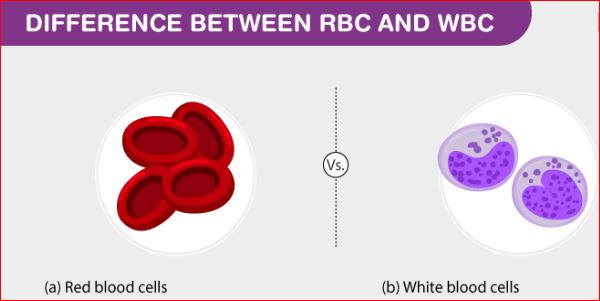What is Difference Between Rbc And Wbc?
Difference Between Rbc And Wbc is that WBC (or White Blood Corpuscles ) and RBC ( Red Blood Corpuscles ) are essential components of blood with vital but distinct functions.
Red blood cells, also called erythrocytes, have a protein called hemoglobin. Blood acquires its color when hemoglobin absorbs oxygen from the lungs. As blood travels through the body, hemoglobin releases oxygen in the tissues. Red blood cells have a life cycle of 4 months and appear in the form of discs with flat bleeding.

White blood cells, also called leukocytes, handle more complex functions. They are the defense mechanism of the human body to fight infections. There are different types of WBC with varied life cycles and different functions. White blood cells also produce a special protein called an antibody that recognizes and fights the presence of foreign elements in the body.
Comparative chart
Comparative chart RBC versus WBC
| RBC | Wbc | |
|---|---|---|
| Physical characteristics | Red blood cells are shaped like a bi-concave disc and have no nucleus. the size is about 6-8 μm | White blood cells have an irregular shape, but they have a nucleus and an outer buffer layer. |
| Life expectancy | 120 days | 4-30 days depending on the body. |
| The types | Only one type of red blood cells is found in the blood. | There are several types of white blood cells with different functions in the blood: neutrophils, T lymphocytes, B lymphocytes (plasma cells), monocytes (macrophages), eosinophils, basophils. |
| Circulatory system | Cardiovascular system | Cardiovascular and lymphatic systems .. |
| Total account RBC 700: 1 WBC | males 4.6 million – 6.2 million per cubic mm females 4.2 million – 5.4 million per cubic mm | 4000 – 11000 per cubic mm |
| Functions | It supplies oxygen to different parts of the body and transports carbon dioxide and other waste products. | Producing antibodies to develop immunity against infections. Some are phagocytic |
| Presence in blood | It represents 36-50% of our blood according to sex, height and weight | About 1% of the blood .. |
| Components | Hemoglobin | Antibodies with MHC antigen cell markers. |
| Production | Produced in red bone marrow .. | Produced in lymph nodes, spleen, etc. |
| Movement | They move in the blood vessels and eventually squeeze through the capillaries, providing O2 and nutrients to the body’s cells. | They leave the blood vessels and move to the site of the lesion. Capable of diapedesis-squeeze between the cells of the blood vessel walls to exit the circulation. |
| Importance of irregularity in counting | A very low red blood cell count will lead to anemia. | The WBC count increases significantly when an infection is present. |
| Cores | Red blood cells have no nuclei in humans | WBC has nuclei in humans |
| Shape | Bicyclova disc | They have different types of shapes and do not change shape when they multiply |
Content: RBC vs WBC
- 1 form differences
- 2 composition
- 3 types
- 4 functions
- 5 blood count
- 5.1 GB count (or white blood cell count)
- 5.2 RBC count
- 5.3 Importance of irregularity in counting.
- 6 references
Differences in form
Red blood cells are shaped like flat-blooded discs, while white blood cells generally have an irregular shape.
Composition
Red blood cells do not have a nucleus and there is no outer layer. In addition to a nucleus, white blood cells have a white layer similar to a buffer, which is responsible for their nomenclature.
The types
Red blood cells have no classification; they come in only one type White blood cells are present in several types, namely. Neutrophils, basophils, and eosinophils, which have different functions.
Functions
The function of red blood cells in the body is to transport oxygen from the lungs to the tissues. Its lifespan is generally about 4 months and the body constantly replenishes red blood cells when they are lost. Red blood cells produce a protein called hemoglobin, which absorbs oxygen from the lungs. Hemoglobin is also what gives color to the blood ..
The function of the White Blood Cells (WBC) is to defend the body from various infections. They produce antibodies that help detect and combat the presence of foreign elements (for example, germs) in the body. They strengthen the defense mechanism, thus improving the body’s immune system against germs. White blood cells also help destroy cancer cells in the early stages.
Blood count
A complete blood count (also known as a Full Blood Count (FBC) or a complete blood test (FBE) or blood panel ) captures measurements for various blood components, including RBC and WBC. Here you can find detailed information about the “normal range” for WBC and RBC
You May Also Interested:
